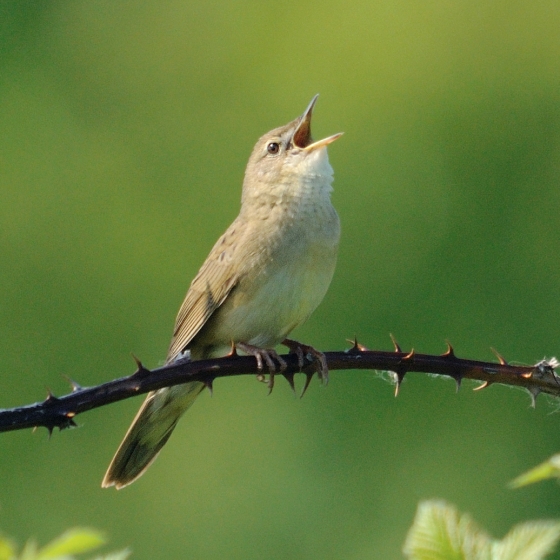Grasshopper Warbler
Locustella naevia (Boddaert, 1783)
GH
 GRAWA
GRAWA  12360
12360

Family: Passeriformes > Locustellidae

A summer visitor to Britain & Ireland, this otherwise nondescript warbler is most easily identified by its cricket-like song.
In the UK, Grasshopper Warbler numbers declined rapidly from the mid-1960s to the mid-1980s. It also underwent a range contraction, especially in southern and central England. It has been on the UK Red List since 2002. In Ireland, this species is on the Amber List. It is a species of lowland reedbeds, grassland and scrub, where it feeds on insects and other invertebrates.
Grasshopper Warblers start to arrive in Britain & Ireland in April and are gone again by October. They spend the winter months in north-west Africa. They can produce up to two broods per breeding season. Males and females look alike, with brown plumage that is paler on the bird's underside.
Exploring the trends for Grasshopper Warbler
Our Trends Explorer will also give you the latest insight into how the UK's Grasshopper Warbler population is changing.
trends explorerIdentification
Grasshopper Warbler identification is often straightforward.
SONGS AND CALLS
Listen to example recordings of the main vocalisations of Grasshopper Warbler, provided by xeno-canto contributors.
Call
Song
Develop your bird ID skills with our training courses
Our interactive online courses are a great way to develop your bird identification skills, whether you're new to the hobby or a competent birder looking to hone your abilities.
Browse training coursesStatus and Trends
Population size and trends and patterns of distribution based on BTO surveys and atlases with data collected by BTO volunteers.
CONSERVATION STATUS
This species can be found on the following statutory and conservation listings and schedules.
POPULATION CHANGE
Grasshopper Warbler was previously amber-listed because of a contraction in range during the period preceding the 1988-91 Atlas (Gibbons et al. 1993). The CBC index suffered from small and severely dwindling sample sizes, but the available data indicate a rapid population decline between the mid 1960s and mid 1980s, when numbers became too small for annual monitoring (Marchant et al. 1990). On this basis, the species is now red-listed. The BBS shows wide fluctuations in abundance since 1995, with no clear trend for the UK and a moderate decline in England. There has been a decline across Europe since 1980 (PECBMS: PECBMS 2020a>).
| UK breeding population |
No population change in UK (1995–2020) 
|
Exploring the trends for Grasshopper Warbler
Our Trends Explorer will also give you the latest insight into how the UK's Grasshopper Warbler population is changing.
trends explorerDISTRIBUTION
Grasshopper Warblers are widespread throughout much of Britain with the exception of high elevations, the Outer Hebrides and Shetland. There are also gaps in parts of northern England, along the Welsh border, and in southern England. They are widespread in Ireland, except in the southeast. The highest densities are found across Ireland, especially the west, as well as in Wales and southwest Scotland.
Occupied 10-km squares in UK
| No. occupied in breeding season | 1800 |
| % occupied in breeding season | 60 |
| No. occupied in winter | 1 |
| % occupied in winter | 0.03 |
European Distribution Map
European Breeding Bird Atlas 2
Breeding Season Habitats
| Most frequent in |
Reedbed 
|
Relative frequency by habitat
Relative occurrence in different habitat types during the breeding season.

DISTRIBUTION CHANGE
Breeding Grasshopper Warblers have been lost from a large swathe across English south-coast counties and also pockets in the east and midlands of Ireland. These substantial losses are offset by a marked gains in Scotland, especially in the northwest, and in the extreme west and southwest of Ireland.
| % change in range in breeding season (1968–72 to 2008–11) | -10.6% |
SEASONALITY
Grasshopper Warbler is a summer migrant, arriving in April when its reeling song enables easy detection. Birds are detected infrequently during autumn migration.

Movement
Information about movement and migration based on online bird portals (e.g. BirdTrack), Ringing schemes and tracking studies.
RINGING RECOVERIES
View a summary of recoveries in the Online Ringing Report.
Foreign locations of birds ringed or recovered in Britain & Ireland

Biology
Lifecycle and body size information about Grasshopper Warbler, including statistics on nesting, eggs and lifespan based on BTO ringing and nest recording data.
PRODUCTIVITY & NESTING
Exploring the trends for Grasshopper Warbler
Our Trends Explorer will also give you the latest insight into how the UK's Grasshopper Warbler population is changing.
trends explorerSURVIVAL & LONGEVITY
View number ringed each year in the Online Ringing Report
Maximum Age from Ringing 
|
5 years 0 months 16 days (set in 1986) 
|
Exploring the trends for Grasshopper Warbler
Our Trends Explorer will also give you the latest insight into how the UK's Grasshopper Warbler population is changing.
trends explorerBIOMETRICS
Wing Length 
|
Adults | 63.8±1.7 | Range 61–67mm, N=790 |
| Juveniles | 64.2±1.6 | Range 62-67mm, N=2655 | |
| Males | 64.6±1.6 | Range 62–67mm, N=221 | |
| Females | 63.3±1.6 | Range 61–66mm, N=95 |
Body Weight 
|
Adults | 13.3±1.13 | Range 11.5–15.2g, N=725 |
| Juveniles | 13.1±1.0894 | Range 11.5–15.0g, N=2601 | |
| Males | 13.1±0.93 | Range 11.7–14.7g, N=193 | |
| Females | 13.6±1.46 | Range 11.5–16.2g, N=85 |
Feather measurements and photos on featherbase 
CODES & CLASSIFICATION
Ring size 
|
A |
Field Codes 
|
2-letter: GH | 5-letter code: GRAWA | Euring: 12360 |
For information in another language (where available) click on a linked name
Research
Interpretation and scientific publications about Grasshopper Warbler from BTO scientists.
CAUSES AND SOLUTIONS
Causes of change
The demographic and ecological causes of population change in this species are largely unknown.
Further information on causes of change
There are not enough data to carry out demographic analyses for this species and the causes of the decline, both demographic and ecological, are largely unknown.
Although there is no specific evidence available, as this species is a migrant, it is possible that it has suffered from changes in conditions in the African Sahel zone along with some other trans-Saharan migrants.
Another hypothesis, again lacking good evidence to support or refute it, is that the decline is related to a recent decrease in the amount of suitable scrub habitat preferred by breeding Grasshopper Warblers. There are strong pointers that structural aspects of preferred habitat are important, including heterogeneity, and it seems likely that breeding habitat is limited, at least in some parts of Britain (Gilbert 2012). However, the Grasshopper Warbler's decline has been fairly steep and perhaps too rapid for gradual changes in scrub habitat availability or post-afforestation decline to be major factors (Riddiford 1983).
Information about conservation actions
There is no strong evidence about the reasons for the decline of the Grasshopper Warbler and, as a result, few specific conservation actions have been proposed to benefit this species. A reduction in suitable scrub habitat is one possible cause (2012): denser, dead vegetation and tussock forming vegetation at ground level; less dense vegetation above 2 m height, soft soil and song posts (see paper for more specific details).
Links to more information from ConservationEvidence.com
Would you like to search for another species?











Share this page